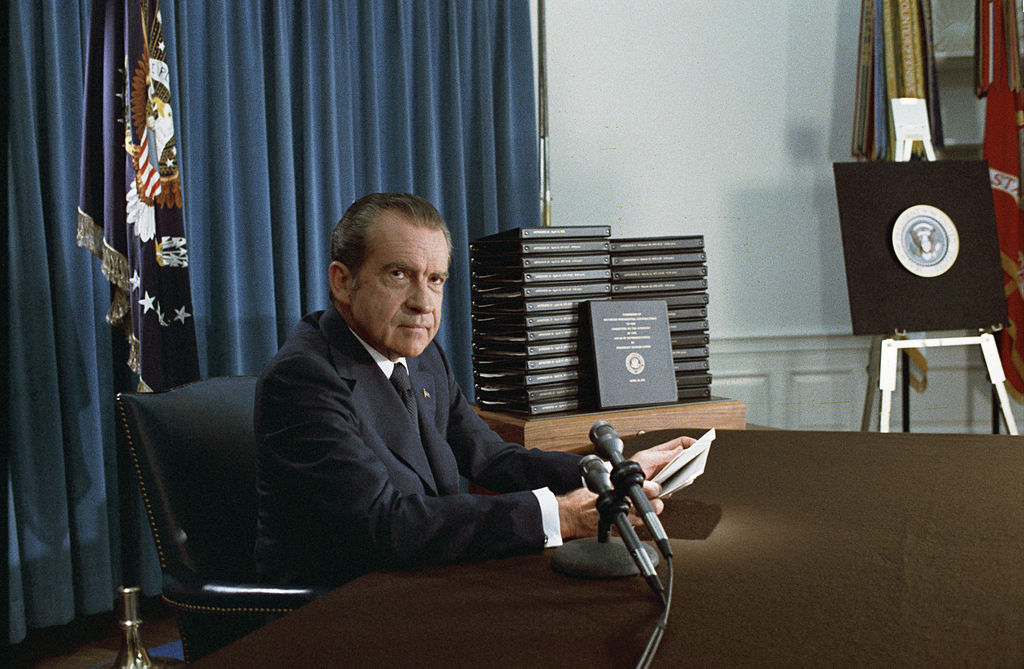Jaworski Road Map to be Mostly Unsealed
One month ago, the three of us filed a petition in the U.S. District Court for the District of Columbia for the release of the so-called “Watergate Road Map”—one of the last great still-secret Watergate documents. Last week, Chief Judge Beryl Howell, acting in a separate case, ordered the document’s release.

Published by The Lawfare Institute
in Cooperation With

One month ago, the three of us filed a petition in the U.S. District Court for the District of Columbia for the release of the so-called “Watergate Road Map”—one of the last great still-secret Watergate documents. Last week, Chief Judge Beryl Howell, acting in a separate case, ordered the document’s release. The move, as Josh Gerstein notes in this Politico story, appears to have been prompted by our petition, on which we have been represented by the folks at Protect Democracy. In that litigation the following day, the government made clear that it means to comply with the order, so the bulk of the Road Map will be released publicly over the coming weeks. This is a very good thing, both for historical understanding of Watergate and for contemporary discussion of Bob Mueller’s planned report.
The Road Map, as we explained in more detail at the time we filed our petition, was actually an impeachment referral, an effort by Special Prosecutor Leon Jaworski’s office,
to provide the House [of Representatives] with some of the evidence it had collected about Nixon’s alleged crimes and let the House decide whether and how the evidence implicated impeachable offenses. The evidence consisted of 800 pages of documents and 13 tape recordings of Nixon’s Oval Office conversations. To assist the House in understanding the evidence, the Special Prosecutor’s Office included a 55-page “Road Map” to the evidence. The Road Map did not contain legal analysis or draw legal conclusions. Each page had a sentence or two of factual statements followed by references to the underlying documents and tapes.
The significance of the document is both historical and contemporary. The historical significance is obvious. Watergate has a spawned a huge literature. Jaworski’s referral is described in that literature, but it has remained under wraps longer even than the identity of Deep Throat.
The contemporary significance is subtler. Mueller is today, according to many press accounts, writing some kind of report—at least on allegations of presidential obstruction of justice, maybe on other matters too. There exist only a few possible models for such a report. In some ways, the Road Map is the one that history has treated most kindly, but it has done so, ironically, without ever seeing it; the documents remains sealed by the National Archives because of grand-jury secrecy rules. We argued that it was time for it to see the light of day.
We actually were not the first to do so. Geoffrey Shepard, a California lawyer who worked for Nixon, sought the Road Map’s release some time back—along with other material—but the matter languished before Judge Royce Lamberth. A few days after we filed our petition, however, the Shepard matter came back to life. The case was transferred to Chief Judge Howell on Sept. 20. Our case, which was also assigned initially to Judge Lamberth, was transferred to Chief Judge Howell the same day. A couple of weeks later, on Oct. 4, the government filed a status report in Shepard, stating:
On June 22, 2017, the National Archives and Records Administration (“NARA”) delivered to Judge Lamberth’s chambers an ex parte, in camera submission, in accordance with the court’s Memorandum and Order of May 23, 2017. That submission consisted of (a) the declaration of Martha Murphy, NARA’s Chief of the Special Access and FOIA Branch, addressing the first Watergate grand jury’s report and recommendation (the “Roadmap”); (b) an index of the Roadmap, plus an illustration of how the Roadmap appeared, both attached to the Murphy declaration, and (c) a box containing a copy of the entire Roadmap, as it was transmitted to the House of Representatives.
The Murphy declaration explained that a majority of the Roadmap had already been made public by the House Judiciary Committee, and thus no longer constituted secret grand jury information. With respect to the non-public portions of the Roadmap, which contain secret grand jury information, NARA was awaiting Judge Lamberth’s ex parte review and decision before it proceeded to conduct an archival review to determine which portions could now be opened to the public. That remains the status to date. Similarly, given the pendency of the ex parte review, the government has not conferred with any individuals who may be affected by a potential disclosure.
Judge Howell did not waste time. Her order, which followed this status report by only a week, directs that “NARA shall promptly begin the process of reviewing and releasing the 2-page summary, 53 statements, and 81 documents described in its ex parte, in camera submission that are included in the House Judiciary Committee Report or that have otherwise been made publicly available. She also ordered “that the Department of Justice shall file, on November 9, 2018, and every 30 days thereafter, a status report informing the Court of the status of NARA’s review process” and that the department “shall, by October 22, 2018, review the 16 remaining documents in the Road Map that NARA has not been able to locate publicly, and shall contact any individuals whose privacy might be implicated by the release of those 16 documents to ascertain their views regarding whether those 16 documents may be released.”
On Friday, the government filed its reply to our petition. In it, the government made clear that the release will, in fact, happen—implying that it does not mean to appeal Chief Judge Howell’s order—and suggested that our case is largely moot as a result:
The petition at issue here seeks an order directing NARA to release the Roadmap. This Court, in the Shepard matter, has already issued such an order. In Re Petition for Order Directing Release of Transcripts of Testimony Before Watergate Grand Juries, Misc. No. 11- 0044, document #26 (Oct. 11, 2018). The forthcoming release constitutes a majority of the Roadmap and its supporting documents. As NARA has explained, the Roadmap consists of a two-page summary statement, followed by 53 individually numbered statements (“Statements of Information”), each of which provides citations to documents supporting that statement. In total, there are 97 documents supporting the 53 Statements of Information. NARA was able to locate duplicates of 81 of the documents included in the Roadmap that had been published or released as part of NARA’s Watergate collection, or are available elsewhere in the public domain. Id. With respect to the Statements of Information (as opposed to the supporting documents), the number of still secret statements is even smaller, with only a few statements likely to be redacted.
The petition in this case is entirely subsumed within the Shepard petition. Indeed, petitioners here have expressly disavowed any intention of seeking the grand jury documents underlying the Statements of Information. See Petition at 2, n.1 (“This petition seeks only the Road Map and not the accompanying records.”). In that respect, this petition is narrower than the Shepard petition, and the forthcoming release in that case will therefore exceed in large part what petitioners in this case have sought. Accordingly, to the extent an order has already issued requiring the release of a majority of the Roadmap, this petition is largely moot.
In short the government acknowledges that “the vast majority of the Statements of Information [that make up the Road Map] will soon be released.” It urges that “For those few statements that remain secret grand jury information, this Court should defer ruling until the D.C. Circuit issues its decision in McKeever. That case addressed squarely the contested issue of whether the district courts have inherent authority to order the disclosure of protected grand jury information for reasons outside those articulated in Criminal Rule of Procedure 6(e).” For a full explanation of the McKeever case, see this oral argument summary by Jeremy Gordon.
In other words, notwithstanding the government’s and our dispute over whether the court has the authority to order the release of grand jury information, the bulk of the Road Map will soon become public. As we argued in our original post, the importance of the Road Map lies less in its specific contents than in its form and structure and style. But the manner in which Jaworski transmitted the evidence he had amassed to Congress so that it could consider that evidence in light of its own constitutional authority is potentially instructive. It may well be on Mueller’s mind as he thinks about the information he has amassed. And it should be on the public’s mind as it evaluates whatever Mueller ends up doing.
We will, of course, post the Road Map as soon as it becomes available.




.jpg?sfvrsn=2f856ee3_5)
